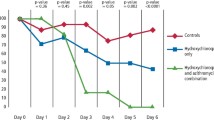Abstract
Data sources A series of eight patients with active COVID-19 who also presented with associated oral lesions seen at a hospital in Sao Paulo, Brazil provided the information in this report.
Study selection The authors reported a case series with eight COVID-19 patients.
Data extraction and synthesis Demographic information, hospitalisation details including signs, symptoms and severity of COVID-19, along with presence of anosmia, dysgeusia, ageusia and oral lesions from all eight patients were documented and reported by the authors.
Results All eight patients in this report presented for medical care with well-established respiratory symptoms of COVID-19. These patients also presented with oral ulcers that resembled aphthous ulcers, of which some also had necrosis and haemorrhagic ulcerations. The time to onset ranged between two to ten days and duration lasted between 5-15 days. The painful ulcers were empirically managed using daily photobiomodulation (PBMT) therapy using a PBMT device (Twin Flex, MMOptics, Sao Carlos, Brazil).
Conclusions Oral lesions may precede COVID-19 and progressively worse oral lesions are seen in severe COVID-19 patients. Some of these oral lesions also tend to occur early along with loss of taste and smell in some patients. Taken together, these oral manifestations could serve as early indication of COVID-19 and prompt referral for further testing is recommended.
Similar content being viewed by others
A commentary on
Brandão T B, Gueiros L A, Melo T S et al.
Oral lesions in patients with SARS-CoV-2 infection: could the oral cavity be a target organ? Oral Surg Oral Med Oral Pathol Oral Radiol 2021; DOI: 10.1016/j.oooo.2020.07.014.

GRADE rating
Commentary
Since the beginning of the COVID-19 pandemic in early 2020, about 68,000 articles have been published and indexed in the database Medline, of which close to 600 are published in dental journals.1 A plethora of papers, mostly case reports and letters to editors, have been published on oral manifestations of COVID-19.2,3,4,5 These manifestations, besides the well-recognised taste alterations, have been wide-ranging, from oral ulcers that appear like aphthous ulcers, herpetiform ulcers, necrotic and haemorrhagic ulcers and blisters, erythema multiforme-like ulcers, erythematous plaques and bullae, vasculitis, angular cheilitis and candidiasis, to salivary gland dysfunction, among others.6,7 This was followed by assessments of many such reports of having incomplete clinical and diagnostic information, and the possibility that reported oral lesions could also be caused by other viruses such as herpes simplex, could be drug-induced and are commonly seen in other systemic diseases.8,9,10,11 Some authors even reported common oral findings such as lateral tongue indentations (due to pressure from adjacent teeth) and geographic tongue as unique COVID-19 oral manifestations, while these are likely coincidental oral findings unrelated to SARS-CoV-2 infection.12,13

© p_saranya/iStock/Getty Images Plus
In this report by Brandao et al., the authors followed up eight patients with confirmed diagnosis of COVID-19 whose oral manifestations had started during the infectious period of COVID-19. The authors did not take samples from the oral lesions to test for viral presence. However, the oral lesions evolved and subsided concurrently with COVID-19, thus leading to the speculation that oral lesions were indeed associated with COVID-19. However, it is still not known if these manifestations are directly caused by the virus or are due to immunosuppression related to COVID-19.14,15 Recent studies have indicated the affinity of the SARS-CoV-2 virus to the oral epithelial cells. The presence of angiotensin-converting enzyme 2 (ACE2) receptors on salivary glands16 and oral epithelial cells (including tongue) is believed to be the specific target for direct viral entry and replication.14,17 Further rigorous longitudinal and basic science studies with appropriate controls are needed to further understand the association between SARS-CoV-2 and oral lesions.
Clinicians must continue to recognise that certain oral findings such as oral ulcers and opportunistic infections occur during COVID-19 and that the exact etiopathogenesis is still unknown. Fortunately, most of these lesions are self-limiting, and hence accurate diagnosis and palliative management focusing on pain relief and oral health quality of life are prudent.
References
National Library of Medicine. PubMed Database. Available at https://pubmed.ncbi.nlm.nih.gov (accessed March 2021).
Chaux-Bodard A, Deneuve S, Desoutter A. Oral manifestation of Covid-19 as an inaugural symptom? J Oral Med Oral Surg 2020; DOI: 10.1051/mbcb/2020011.
Martín Carreras-Presas C, Amaro Sánchez J, López-Sánchez A F, Jané-Salas E, Somacarrera Pérez M L. Oral vesiculobullous lesions associated with SARS-CoV-2 infection. Oral Dis 2021; 27 Suppl 3: 710-712.
Díaz Rodríguez M, Jimenez Romera A, Villarroel M. Oral manifestations associated with COVID-19. Oral Dis 2020; DOI: 10.1111/odi.13555.
Galván Casas C, Català A, Carretero Hernández G et al. Classification of the cutaneous manifestations of COVID-19: a rapid prospective nationwide consensus study in Spain with 375 cases. Br J Dermatol 2020; 183: 71-77.
Riad A, Kassem I, Hockova B, Badrah M, Klugar M. Tongue ulcers associated with SARS-CoV-2 infection: A case series. Oral Dis 2020; DOI: 10.1111/odi.13635.
Iranmanesh B, Khalili M, Amiri R, Zartab H, Aflatoonian M. Oral manifestations of COVID-19 disease: A review article. Dermatol Ther 2021; DOI: 10.1111/dth.14578.
Ponce J B, Tjioe K C. Overlapping findings or oral manifestations in new SARS-CoV-2 infection. Oral Dis 2021; 27 Suppl 3: 781-782.
Abu-Hammad S, Dar-Odeh N, Abu-Hammad O. SARS-CoV-2 and oral ulcers: A causative agent or a predisposing factor? Oral Dis 2020; DOI: 10.1111/odi.13498.
Rocha A L, de Souza A F, Resende R G. Current evidence on possible oral manifestations of SARS-CoV-2 infection. Oral Dis 2020; DOI: 10.1111/odi.13517.
Martín Carreras-Presas C, Amaro Sánchez J, López-Sánchez A F, Jané-Salas E, Somacarrera Pérez M L. SARS-CoV-2 oral-associated lesions: Discussion of elicited response. Oral Dis 2020; DOI: 10.1111/odi.13532.
Nuno-Gonzalez A, Martin-Carrillo P, Magaletsky K et al. Prevalence of mucocutaneous manifestations in 666 patients with COVID-19 in a field hospital in Spain: oral and palmoplantar findings. Br J Dermatol 2021; 184: 184-185.
Pérez-Sayáns M, Ortega K L, Braz-Silva P H, Martín Carreras-Presas C, Blanco Carrión A. Can "COVID-19 tongue" be considered a pathognomonic finding in SARS-CoV-2 infection? Oral Dis 2021; DOI: 10.1111/odi.13807.
Brandini D A, Takamiya A S, Thakkar P, Schaller S, Rahat R, Naqvi A R. Covid-19 and oral diseases: Crosstalk, synergy or association? Rev Med Virol 2021; DOI: 10.1002/rmv.2226.
Amorim Dos Santos J, Normando A G C, Carvalho da Silva R L et al. Oral mucosal lesions in a COVID-19 patient: New signs or secondary manifestations? Int J Infect Dis 2020; 97: 326-328.
Xu J, Li Y, Gan F, Du Y, Yao Y. Salivary Glands: Potential Reservoirs for COVID-19 Asymptomatic Infection. J Dent Res 2020; 99: 989.
Sawa Y, Ibaragi S, Okui T, Yamashita J, Ikebe T, Harada H. Expression of SARS-CoV-2 entry factors in human oral tissue. J Anat 2021; DOI: 10.1111/joa.13391.
Author information
Authors and Affiliations
Rights and permissions
About this article
Cite this article
Kumar, S. Could the oral cavity be a target organ in SARS-CoV-2 infection?. Evid Based Dent 22, 78–79 (2021). https://doi.org/10.1038/s41432-021-0174-2
Published:
Issue Date:
DOI: https://doi.org/10.1038/s41432-021-0174-2



